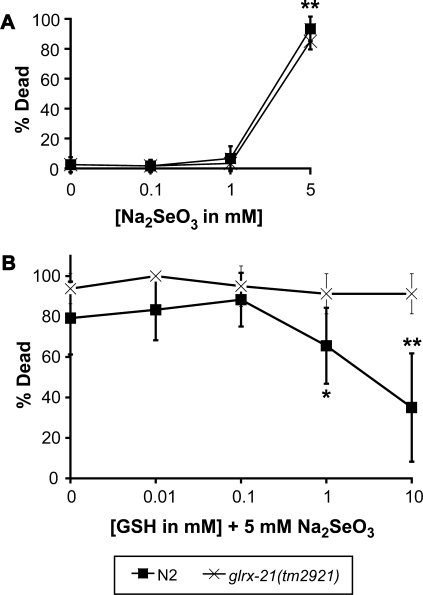FIG. 4.
Selenium-induced lethality of a glutaredoxin mutant is not decreased by GSH. Animals were scored for lethality after 12-h exposure to (A) 5mM Na2SeO3 or (B) both 5mM Na2SeO3 and increasing concentrations of GSH (0–10mM). (A) Comparison of the selenium-induced lethality of the wild-type strain N2 (▪), and the glutaredoxin mutant strain, glrx-21(tm2921) (x). Each data point represents the averages of four to six plates with 10 animals per plate and is presented as the mean percentage of dead animals ± SD. ** p < 0.001, for wild-type and the glrx-21 mutant strain exposed to 5mM Na2SeO3 and compared across all other concentrations of Na2SeO3 (one-way ANOVA). Note. There is no statistically significant difference in lethality between wild-type and the glrx-21 mutant strain when compared within each concentration of Na2SeO3 (Student’s t-test) and across all concentrations except 5mM Na2SeO3 (one-way ANOVA). (B) The effects of reduced GSH on the selenium-induced lethality of the wild-type strain N2 (▪), and the glutaredoxin mutant strain, glrx-21(tm2921) (x). Each data point represents the averages of 4–13 plates with 10 animals per plate and is presented as the mean percentage of dead animals ± SD. Note. There is no statistically significant difference in lethality for the glrx-21 mutant strain when compared across all concentrations of GSH (0-10mM) tested (one-way ANOVA). *p < 0.05, compared with all concentrations of GSH (0.01–10mM) exposed wild-type animals and glrx-21 mutant animals, as well as the control (0mM GSH) for the glrx-21 mutant strain; **p < 0.01, compared across all concentrations of GSH (0.01–10mM) and controls for both the wild-type and glrx-21 mutant strains.

